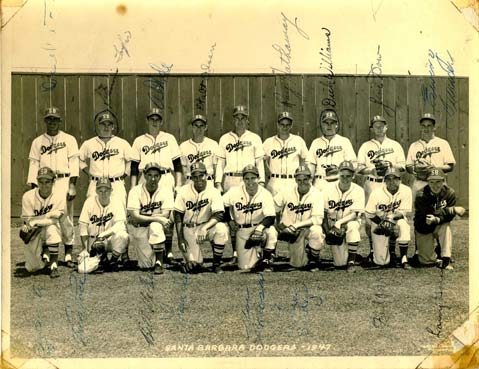Pro Baseball in S.B.
In 1941 a Brooklyn Farm Club Took Up Residence in S.B.

Professional baseball in Santa Barbara actually began as a hedge against the ravages of the Depression. After an exhibition series here in 1933, the Pittsburgh Pirates hinted at the possibility of making Santa Barbara its spring training site, a potential windfall for the city. The Junior Chamber of Commerce spearheaded a drive to transform a two-block site bounded by Ortega, Cota, Garden, and Olive streets into a ballpark. Springs at this marshy site had originally supplied water for the Royal Presidio and later for an orchard planted by José de la Guerra. By the 1920s, the site was being used as a dump. In fact, in 1928, a stubborn underground fire sent hundreds of rats scurrying to find more hospitable quarters in surrounding neighborhoods.
A ballpark could only be an improvement. With a combination of city funds and money from two federal agencies, including $15,000 from the WPA, Laguna Park was dedicated in April 1939, at a cost of some $35,000. The architect was Winsor Soule. The stands only seated a little more than 2,000, but the field itself was quite spacious; the distance from home plate to the centerfield wall was more than 400 feet.
In 1941, a Brooklyn Dodger farm club, the Saints, took up residence. The team played in the California League, then designated as a Class C league, which would be equivalent to Class A today. Play was suspended during the Second World War, but then came what may be considered the golden age of professional baseball in Santa Barbara. The team was renamed the Dodgers, and success was enjoyed both on the field and off. In 1947, Santa Barbara set a California League attendance record of almost 93,000.
The good times did not last, however. Fog could be a problem, and when visibility was reduced to 10 feet, games had to be canceled. The low-lying field had a propensity to flood (the ballpark, unfortunately, seemed to be well-named). The advent of television devastated minor leagues across the nation. Who would want to pay to see minor leaguers when one could watch the majors in the comfort of their own home for free? Finally, in 1953, the Dodgers relocated.
Still, there had been some mighty interesting baseball throughout the years, such as the time in 1951 when a player bunted for a home run or when the Bakersfield player-manager put himself in as a pitcher and promptly gave up 14 consecutive walks. Only in the minor leagues. Santa Barbara had its share of future major leaguers. The 1942 third baseman, “Spider” Jorgensen, went on to play with Brooklyn for a number of years. Other players of note included Ron Fairly and Al Gionfriddo, who made a famous catch in the 1947 World Series. Sparky Anderson, who went on to great success as manager of the Cincinnati Reds of the early 1970s and later the Detroit Tigers also played here.
Organized ball returned in 1961 with the Rancheros, a farm team of the expansion New York Mets, whose 1962 team, loser of 120 games and managed by Casey Stengel, was arguably the worst major league team of the 20th century. In 1964, the Met affiliation was replaced by the return of a Dodger farm club, but attendance then averaged only about 225 a game. The year 1967 marked the end of minor league baseball in Santa Barbara; the team moved to Bakersfield after incurring a loss of some $100,000. In 1970, the park was torn down to make way for a consolidated equipment yard for the city. Yet in some ways, the legacy lives on; reportedly, Hollywood director Ron Shelton, who grew up in Santa Barbara, very much had Laguna Park in mind when he made his popular film about minor league baseball, Bull Durham.



